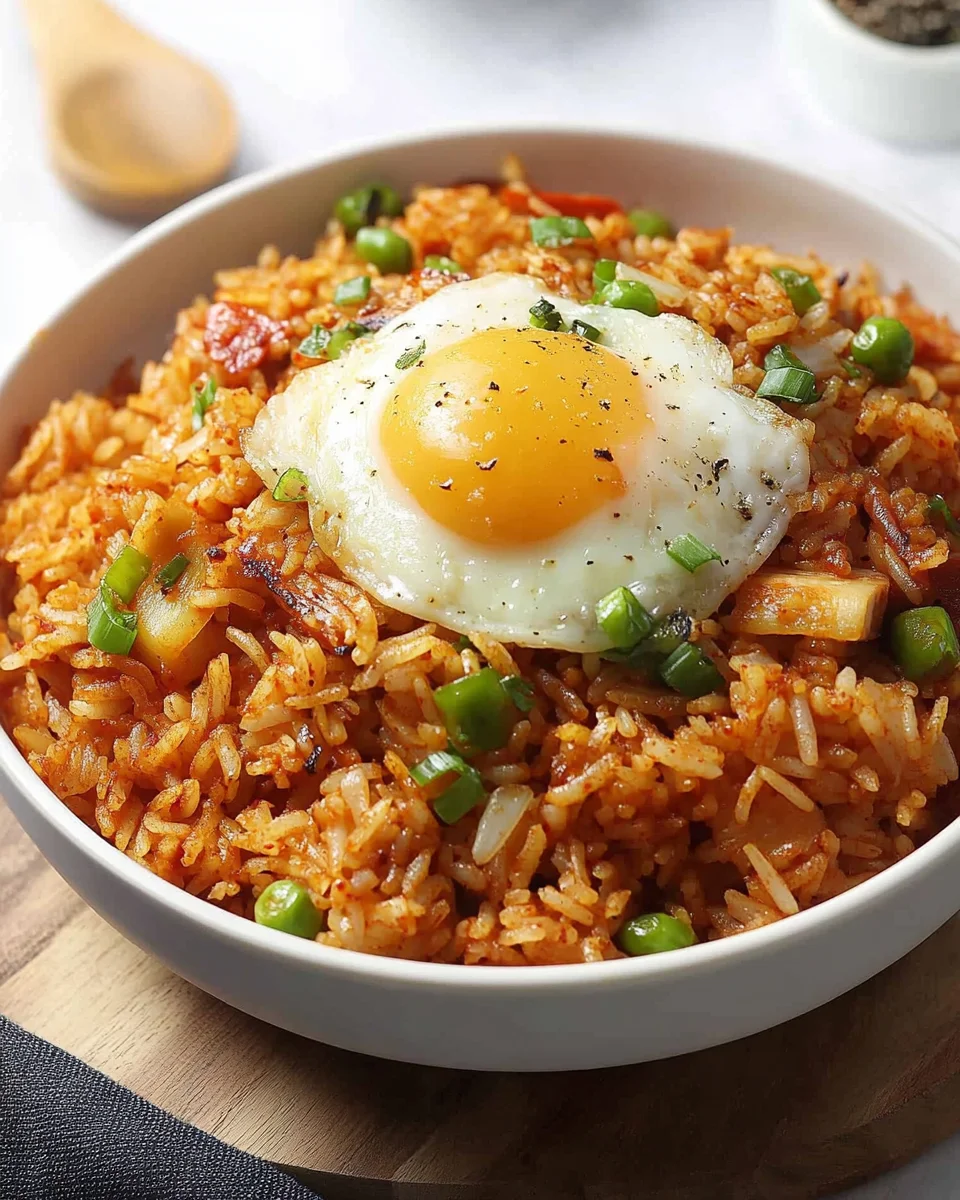Introduction: A Spicy and Satisfying One-Pan Dish
If you’re a fan of bold, umami-packed dishes, Gochujang Fried Rice is about to become your new favorite meal. This Korean-inspired fried rice takes a classic comfort dish and elevates it with the deep, rich, and slightly smoky heat of gochujang, Korea’s famous fermented red chili paste.
Fried rice is already a beloved dish across various cuisines, prized for its simplicity, versatility, and ability to use up leftovers. Adding gochujang to the mix transforms this dish into something truly addictive—spicy, slightly sweet, and packed with umami depth. Whether you’re making it as a quick weeknight meal or as a base for a more elaborate dish, gochujang fried rice offers restaurant-quality flavors in under 30 minutes.
In this guide, we’ll explore the history of gochujang, serving suggestions, creative variations, frequently asked questions, and expert tips to help you perfect this irresistible dish.
What Is Gochujang? A Deep Dive into Korea’s Iconic Ingredient
Gochujang is a fermented Korean chili paste made from a blend of red chili powder, fermented soybeans, glutinous rice, and salt. The result is a deep red, thick paste with a spicy, slightly sweet, and umami-packed flavor.
Why Is Gochujang So Special?
- Complex Flavor – Unlike simple hot sauces, gochujang has layers of spice, sweetness, and savoriness thanks to its fermentation process.
- Versatile Ingredient – Used in everything from bibimbap and tteokbokki to marinades and stir-fries.
- Health Benefits – Contains probiotics from fermentation and is rich in vitamins and antioxidants.
In this fried rice recipe, gochujang acts as the flavor powerhouse, bringing a deep, smoky heat that makes every bite rich and satisfying.
Why You’ll Love Gochujang Fried Rice
1. It’s a Flavor Bomb
Unlike traditional fried rice, which relies on soy sauce for saltiness, gochujang adds an entirely new layer of complexity. The combination of spice, mild sweetness, and umami makes it irresistible.
2. Quick and Easy to Make
- Ready in under 30 minutes, perfect for busy weeknights.
- Uses leftover rice, reducing food waste.
- Requires minimal ingredients but delivers maximum flavor.
3. Customizable to Your Taste
- Want extra heat? Add more gochujang or chili flakes.
- Prefer a milder version? Adjust the amount of paste and balance with more soy sauce.
- Need more protein? Add chicken, shrimp, tofu, or a fried egg on top.
4. Pairs Well with Many Dishes
Gochujang fried rice can be a standalone meal, but it also pairs beautifully with:
- Korean BBQ – Serve alongside grilled bulgogi or spicy pork.
- Kimchi – Adds extra tang and spice.
- Pickled Vegetables – Balances the richness with acidity.
How to Serve Gochujang Fried Rice: The Best Pairings
While this dish is incredible on its own, pairing it with complementary side dishes can make it even more exciting.
1. Classic Korean Pairings
- Kimchi – The fermented tanginess of kimchi balances the richness of the rice.
- Korean BBQ meats – Bulgogi (beef), samgyeopsal (pork belly), or dak-galbi (spicy chicken) make fantastic additions.
2. Add Some Crunch and Refreshing Contrast
- Cucumber salad – A cool and crisp side to balance the spice.
- Pickled radish – The sweetness and acidity cut through the richness.
3. Elevate It with a Protein Boost
- Top with a fried egg – The creamy yolk creates a delicious sauce that coats the rice.
- Add tofu, shrimp, or chicken for a heartier meal.
4. Drizzle on Some Extra Flavor
- Sesame oil – Adds a nutty, aromatic finish.
- Sriracha or extra gochujang – If you love more heat.
Creative Variations: Make It Your Own
One of the best things about fried rice is how adaptable it is. Here are some ways to switch up your gochujang fried rice:
1. Protein-Packed Gochujang Fried Rice
- Chicken or shrimp – Sauté bite-sized pieces before adding the rice.
- Tofu or tempeh – A great vegetarian option that soaks up the spicy sauce.
2. Extra Veggie Loaded Version
- Toss in spinach, mushrooms, bok choy, zucchini, or bell peppers for added nutrition.
3. Kimchi Gochujang Fried Rice
- Stir in chopped kimchi for an extra punch of fermented tang and umami.
4. Low-Carb Version
- Swap rice for cauliflower rice or quinoa for a healthier twist.
5. Sweet and Spicy Fusion
- Add a teaspoon of honey or maple syrup to balance the spice with a touch of sweetness.
Spicy Gochujang Fried Rice: A Flavor-Packed Korean Classic
Ingredients: The Perfect Blend of Heat and Umami
- Day-old cooked rice – The key to achieving the perfect fried rice texture
- Vegetable oil – High smoke point oils like peanut or avocado work best
- Onion and garlic – Adds a deep aromatic base
- Frozen peas and carrots – A convenient and colorful addition
- Unsalted butter – Enhances richness and depth
- Soy sauce – Provides umami and saltiness
- Gochujang (Korean red chili paste) – The star ingredient, delivering spice and umami
- Sesame oil – Adds nutty complexity
- Eggs – Fried or scrambled, adding creaminess and protein
- Sesame seeds and green onions – For garnish and extra crunch
Directions: Bringing the Heat to Your Kitchen
Step 1: Prep the Ingredients
- Ensure your rice is day-old and cold to prevent it from turning mushy.
Step 2: Sauté the Aromatics
- Heat vegetable oil in a pan and sauté onion and garlic until fragrant.
Step 3: Fry the Rice
- Add rice in batches, pressing it into the pan to get crispy edges.
Step 4: Mix in the Flavor
- Stir in peas, carrots, soy sauce, gochujang, and butter until evenly coated.
Step 5: The Finishing Touch
- Fry eggs separately and serve them on top of the rice.
- Garnish with sesame seeds and green onions.
Nutritional Breakdown: A Balanced Bite
- Calories: 429 kcal
- Carbohydrates: 44g
- Protein: 12g
- Fat: 23g
- Sodium: 393mg
- Fiber: 2g
This Gochujang Fried Rice is the perfect balance of spice, sweetness, and umami, making it a must-try for fans of bold flavors!
Frequently Asked Questions About Gochujang Fried Rice
1. What Does Gochujang Taste Like?
Gochujang has a spicy, slightly sweet, and deeply umami flavor with a fermented tang. It’s not just heat—it’s complex and flavorful.
2. How Spicy Is This Dish?
This dish has a medium spice level, but it can be adjusted:
- For more spice: Add extra gochujang or chili flakes.
- For less spice: Use less gochujang and balance with more soy sauce.
3. Can I Use Fresh Rice Instead of Day-Old Rice?
It’s highly recommended to use day-old rice because fresh rice is too moist and can become mushy. If you must use fresh rice, spread it out on a tray and refrigerate it for an hour before cooking.
4. Where Can I Buy Gochujang?
Gochujang is available at Asian grocery stores, international aisles in supermarkets, or online (Amazon, Walmart, etc.). Look for brands like Chung Jung One or Sempio.
5. How Long Does Leftover Fried Rice Last?
Gochujang fried rice can be stored in an airtight container in the fridge for 4-5 days. Reheat in a pan over medium heat for the best texture.
6. Can I Freeze Gochujang Fried Rice?
Yes! Freeze portions in airtight containers for up to 2 months. Thaw overnight in the fridge and reheat on the stove with a little oil.
Conclusion: Why You Should Try Gochujang Fried Rice
Gochujang Fried Rice is more than just a quick and easy dish—it’s a celebration of bold flavors, rich umami, and the magic of Korean cuisine. Whether you’re craving something spicy and satisfying, looking for a way to use up leftovers, or simply want to explore new flavors, this dish is a must-try.
With its customizable ingredients, quick cooking time, and unbeatable depth of flavor, gochujang fried rice is the perfect addition to your weekly meal rotation.
So why wait? Grab your day-old rice, a spoonful of gochujang, and start frying up a meal that’s as comforting as it is exciting!

Gochujang Fried Rice: A Bold and Flavorful Korean Classic
Ingredients
Method
- Prep the Ingredients: Ensure your rice is day-old and cold to prevent it from turning mushy.
- Sauté the Aromatics: Heat vegetable oil in a pan and sauté onion and garlic until fragrant.
- Fry the Rice: Add rice in batches, pressing it into the pan to get crispy edges.
- Mix in the Flavor: Stir in peas, carrots, soy sauce, gochujang, and butter until evenly coated.
- The Finishing Touch: Fry eggs separately and serve them on top of the rice. Garnish with sesame seeds and green onions.
Notes
- Adjust Spice Level: Reduce gochujang for a milder dish.
- Add Protein: Toss in tofu, shrimp, or chicken for extra variety.
- Storage: Store leftovers in an airtight container in the refrigerator for up to 3 days.
- Reheating: Warm in a pan over low heat, adding a splash of water if needed.

